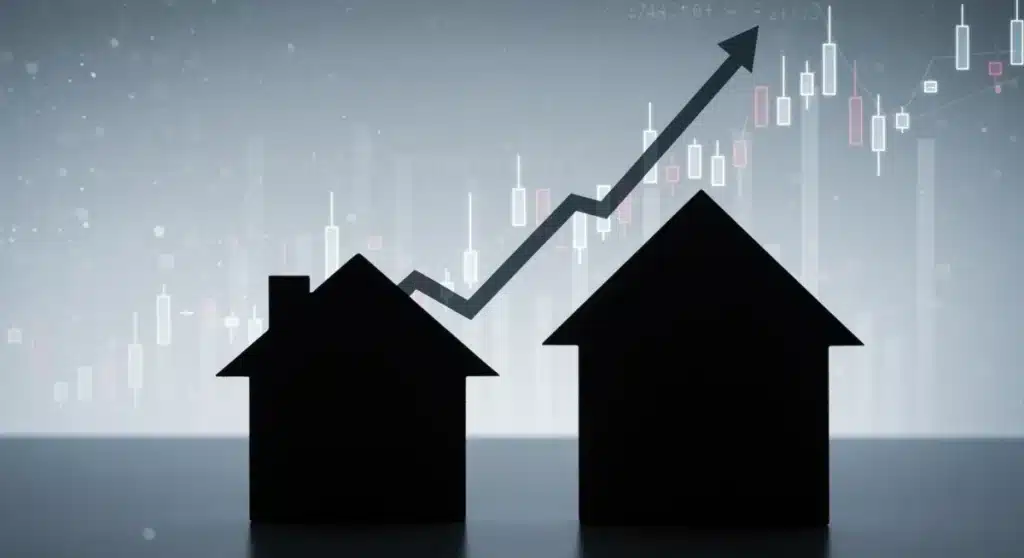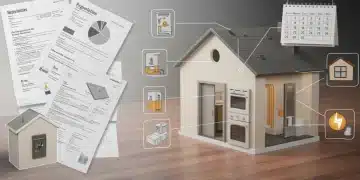Navigating the 2025 Mortgage Rate Forecast: What 6.5% Means

Navigating the 2025 mortgage rate forecast: What a 6.5% average means for your purchase is critical for prospective homebuyers and current homeowners to understand the evolving landscape of housing finance.
Navigating the 2025 Mortgage Rate Forecast: What a 6.5% Average Means for Your Purchase is now a central concern for individuals and families considering real estate transactions. With recent analyses pointing towards an average mortgage rate of 6.5% next year, understanding these projections is vital for making informed decisions in an ever-shifting housing market.
Understanding the 2025 Mortgage Rate Projections
Recent economic forecasts, as of late 2024, indicate a cautious but stable outlook for the housing market in 2025. Key financial institutions and economists are projecting an average 30-year fixed mortgage rate around 6.5%. This projection is based on a confluence of factors, including anticipated Federal Reserve policies, inflation trends, and overall economic growth.
While 6.5% represents an average, it’s crucial to recognize that rates can fluctuate. Several elements contribute to these predictions, offering a clearer picture of what lies ahead for prospective buyers and those considering refinancing.
Factors Influencing Mortgage Rates
Mortgage rates are not static; they are highly responsive to various economic indicators. Understanding these underlying forces helps explain why a 6.5% average is projected for 2025.
- Federal Reserve Policy: The Fed’s decisions on the federal funds rate directly impact borrowing costs across the economy, including mortgage rates.
- Inflation Data: Persistent inflation often prompts the Fed to maintain higher rates to cool the economy, influencing long-term mortgage trends.
- Treasury Yields: The yield on 10-year Treasury bonds is a strong indicator for 30-year fixed mortgage rates, as they tend to move in tandem.
- Economic Growth: A strong economy generally leads to higher rates as demand for credit increases, while a weakening economy might see rates fall.
Impact on Homebuyers: Affordability and Purchasing Power
A 6.5% average mortgage rate significantly impacts the affordability landscape for homebuyers. Higher rates mean higher monthly payments for the same loan amount, effectively reducing purchasing power. This scenario necessitates a more strategic approach to homebuying.
Prospective buyers must recalculate their budgets and consider how these rates affect their debt-to-income ratios. The dream home might become more expensive, pushing some buyers to adjust their expectations regarding property size, location, or amenities.
Budgeting for a 6.5% Rate Environment
In an environment where rates average 6.5%, meticulous financial planning becomes paramount. Buyers need to assess their financial health, save diligently for a down payment, and explore all available financing options.
- Increased Monthly Payments: Understand that a 6.5% rate will result in higher monthly mortgage payments compared to periods of lower rates.
- Reduced Loan Eligibility: Lenders evaluate affordability based on income and debt. Higher rates can reduce the maximum loan amount for which a buyer qualifies.
- Down Payment Importance: A larger down payment can help mitigate the impact of higher rates by reducing the principal loan amount.
- Credit Score Significance: A strong credit score remains vital for securing the most favorable terms, even in a higher rate environment.
Refinancing Considerations in 2025
For current homeowners, the 2025 mortgage rate forecast of 6.5% presents a different set of considerations, particularly for those contemplating refinancing. If current rates are significantly higher than this projected average, refinancing might become an attractive option. Conversely, those with much lower rates secured previously may find little incentive to refinance.
Homeowners should carefully evaluate their existing mortgage terms against the projected 2025 rates. The decision to refinance is complex, involving closing costs, the length of ownership, and personal financial goals. It’s not a one-size-fits-all solution and requires personalized analysis.
When to Consider Refinancing
The optimal time to refinance depends on individual circumstances and market conditions. With a 6.5% average rate on the horizon, homeowners should monitor their current rates and compare them to the market.
- Rates Above 6.5%: If your current rate is substantially higher than 6.5%, refinancing could lead to significant monthly savings.
- Loan Term Adjustment: Refinancing can also be used to shorten or lengthen the loan term, aligning with new financial objectives.
- Cash-Out Refinancing: Homeowners might consider a cash-out refinance to access home equity, but this decision should be weighed against the new, potentially higher interest rate.
- Debt Consolidation: Consolidating high-interest debt into a new mortgage might be appealing, but evaluate the long-term cost implications.
The Broader Housing Market Picture
The projected 6.5% average mortgage rate for 2025 will undoubtedly influence the broader housing market. We can anticipate shifts in buyer demand, inventory levels, and potentially home price appreciation. A moderately higher rate environment tends to cool down aggressive price growth, making the market more balanced.
However, the impact isn’t uniform across all regions. Local market dynamics, population growth, and economic health will continue to play significant roles in how these rates manifest at a granular level.

Market Adjustments and Trends
The housing market’s response to these rate projections will be multifaceted. Industry experts are closely watching several indicators to gauge the full extent of the impact.
- Moderated Price Growth: Higher rates can temper demand, leading to more sustainable, albeit slower, home price appreciation.
- Increased Inventory: A slowdown in buyer activity might result in more homes staying on the market longer, increasing available inventory.
- Shift in Buyer Demographics: First-time homebuyers, particularly those with less accumulated wealth, may face greater challenges, potentially shifting the demographic of active buyers.
- Builder Response: Homebuilders may adjust their strategies, focusing on more affordable housing options or delaying new projects in response to market changes.
Strategies for Prospective Buyers and Sellers
Given the 2025 mortgage rate forecast, both prospective buyers and sellers need to adapt their strategies. Buyers should prioritize financial readiness and be prepared to act decisively. Sellers, on the other hand, may need to adjust their pricing expectations and marketing approaches to attract buyers in a slightly less frenzied market.
For buyers, pre-approval remains a powerful tool, providing clarity on affordability and strengthening offers. For sellers, understanding local market conditions and pricing competitively will be key to a successful sale.
Navigating the Market as a Buyer
Entering the market in 2025 requires a proactive and informed approach. Preparation is the best defense against market volatility.
- Get Pre-Approved: This clarifies your budget and shows sellers you are a serious buyer.
- Save for a Larger Down Payment: Reduces your loan amount and monthly payments.
- Explore Loan Options: Research different types of mortgages (e.g., FHA, VA) that might offer more favorable terms.
- Work with a Knowledgeable Agent: A local real estate expert can provide invaluable insights into market trends and negotiation strategies.
Navigating the Market as a Seller
Sellers also need to be strategic to attract buyers in a 6.5% rate environment. Flexibility and realistic expectations are crucial.
- Price Competitively: Overpricing can deter buyers, especially when borrowing costs are higher.
- Enhance Curb Appeal: First impressions matter. Invest in minor repairs and staging to make your home more attractive.
- Be Flexible on Negotiations: Be open to negotiating on price or offering concessions, such as covering some closing costs.
- Understand Your Local Market: Work with an agent who understands the specific dynamics of your area.
Expert Insights and Future Outlook
Financial analysts and real estate experts are closely monitoring economic indicators to refine their 2025 mortgage rate forecast. While 6.5% serves as a current average projection, it’s important to remember that these are dynamic predictions subject to change based on evolving economic data. The Federal Reserve’s stance on inflation and employment will be particularly influential.
Many experts anticipate a gradual stabilization of rates, potentially with minor fluctuations. The consensus leans towards a market that, while more expensive than the ultra-low rate environment of previous years, will offer more predictability than the volatile period experienced recently. This stability could foster more confident decision-making among both buyers and sellers.
Key Considerations Moving Forward
As we move closer to 2025, several factors will continue to shape the mortgage rate landscape. Staying informed is the best way to prepare for potential shifts.
- Inflation Trajectory: Continued moderation of inflation will be key to preventing further rate hikes.
- Geopolitical Events: Global events can introduce uncertainty, impacting financial markets and interest rates.
- Employment Data: Strong employment figures can signal economic strength, potentially influencing the Fed’s rate decisions.
- Housing Inventory: The balance between housing supply and demand will continue to play a role in market dynamics.
| Key Point | Brief Description |
|---|---|
| 2025 Rate Forecast | Economists project an average 30-year fixed mortgage rate around 6.5% for 2025. |
| Buyer Impact | Higher rates reduce purchasing power and increase monthly payments, requiring budget adjustments. |
| Refinancing Decisions | Homeowners with rates above 6.5% may find refinancing beneficial; others may not. |
| Market Dynamics | Anticipate moderated price growth, potentially increased inventory, and shifts in buyer behavior. |
Frequently Asked Questions About 2025 Mortgage Rates
The current consensus among financial experts and institutions projects an average 30-year fixed mortgage rate around 6.5% for 2025. This forecast is subject to ongoing economic developments and Federal Reserve policies, which can cause minor fluctuations.
A 6.5% average rate will generally lead to higher monthly mortgage payments and could reduce your overall purchasing power. It is crucial to re-evaluate your budget, consider a larger down payment, and explore various loan options to manage affordability effectively.
If your current mortgage rate is significantly higher than 6.5%, then refinancing might be a beneficial option to lower your monthly payments or adjust your loan terms. However, consider closing costs and your long-term financial goals before making a decision.
Several factors can influence the forecast, including the Federal Reserve’s interest rate decisions, inflation trends, the yield on 10-year Treasury bonds, and overall economic growth. Geopolitical events and employment data also play significant roles in market stability.
Prospective homebuyers should prioritize getting pre-approved for a mortgage, saving for a substantial down payment, and working with an experienced real estate agent. Researching different loan programs and understanding local market conditions are also vital for success.
What This Means
The projected 6.5% average mortgage rate for 2025 signals a more normalized, albeit more expensive, lending environment compared to recent years. This outlook impacts everything from individual purchasing power to broader housing market dynamics, suggesting a cooling of rapid price appreciation and a potential increase in inventory. Both buyers and sellers must stay agile, informed, and prepared to adapt their strategies to these evolving conditions. The market demands careful planning and a clear understanding of financial realities.





